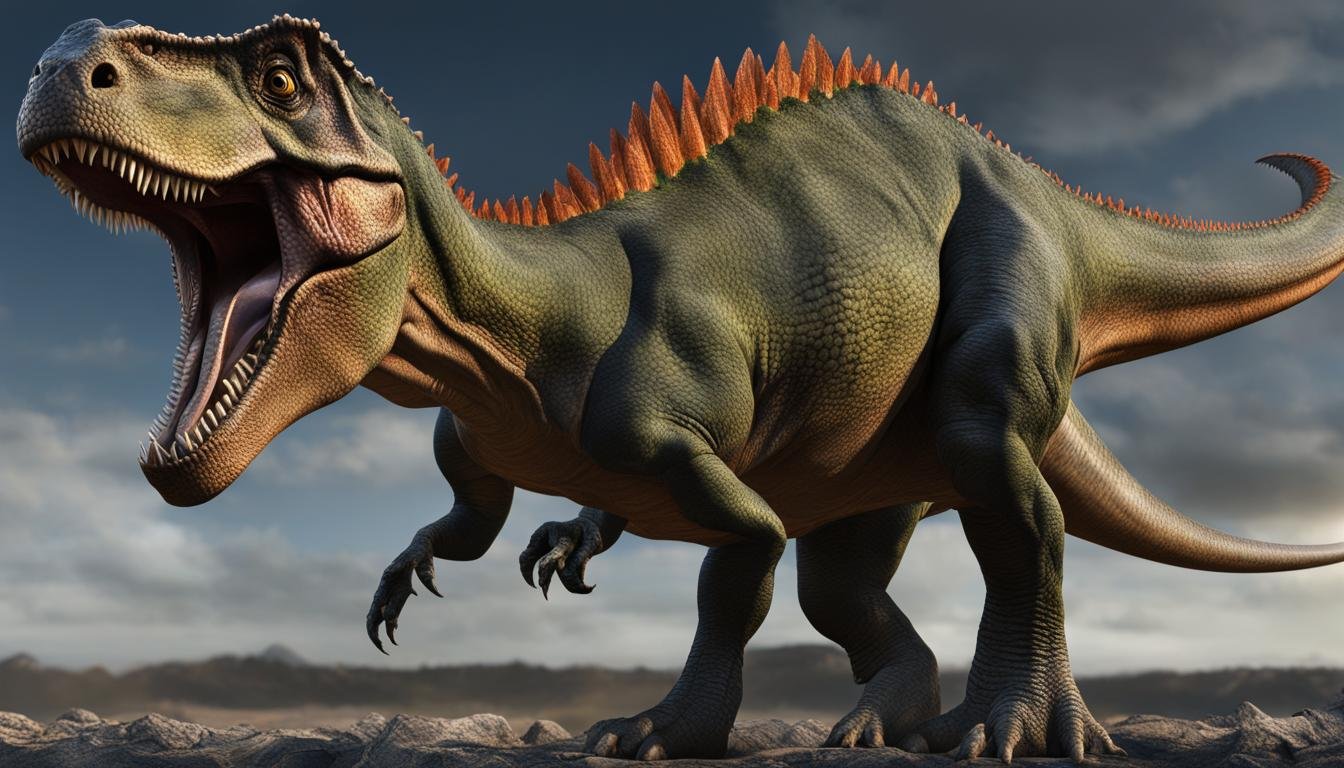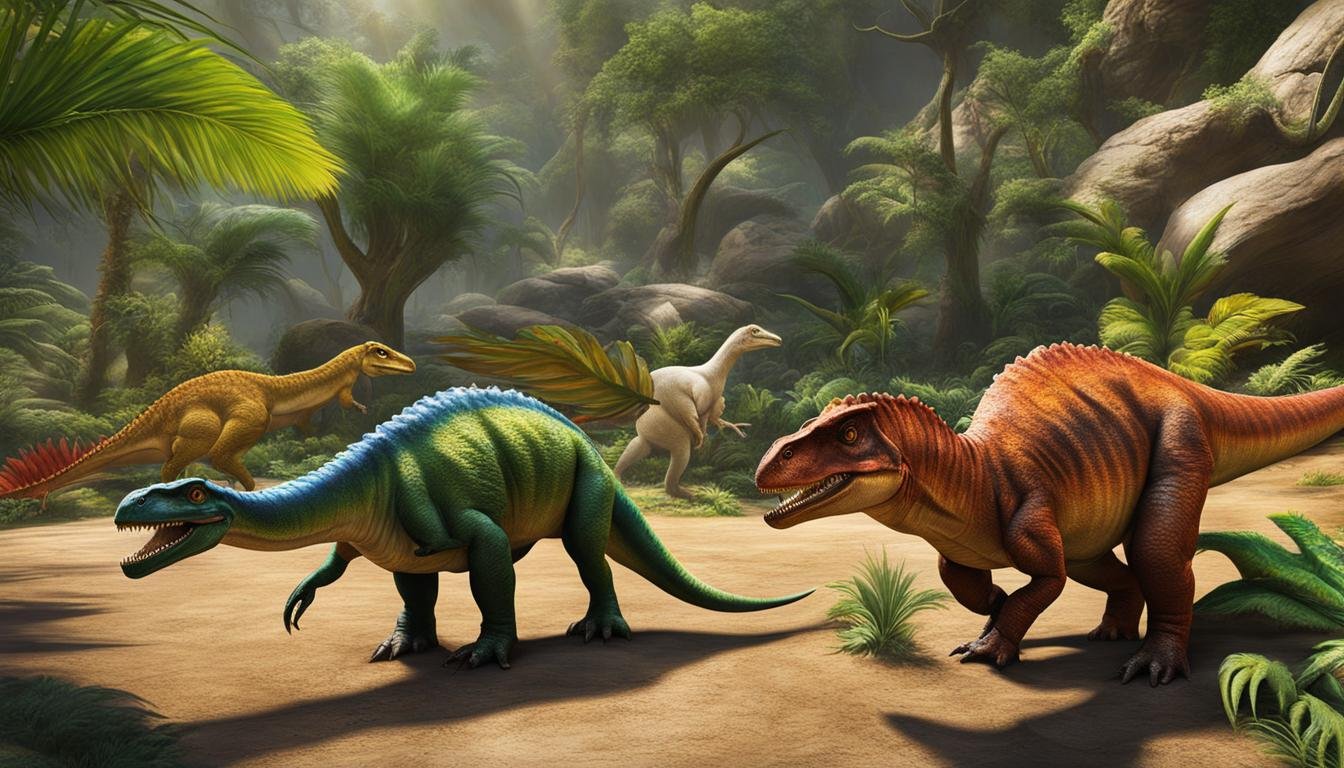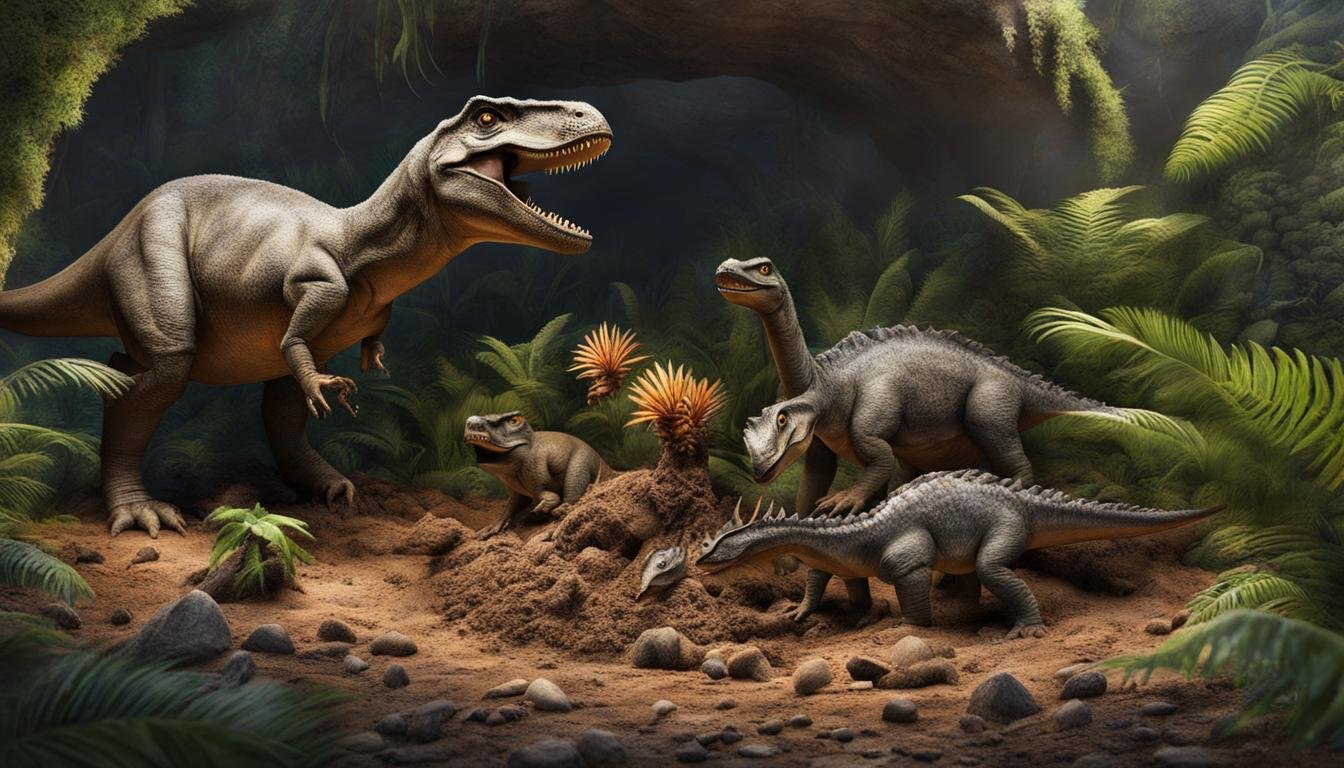Dinosaur eggs have long fascinated scientists and paleontologists, providing valuable insights into the reproductive strategies and embryonic development of these ancient creatures. Understanding the structure and development of dinosaur eggs is key to unraveling the mysteries of their existence.
When it comes to dinosaur eggs, their shape, size, and shell thickness play a crucial role in classification. The eggshell not only protects the developing embryo but also allows for gas exchange with the external environment. By studying dinosaur egg parataxonomy, scientists gain insights into egg-laying behaviors, reproductive physiology, and embryonic development.
Classification of Dinosaur Eggs
Dinosaur eggs are classified based on their size, shape, shell ornamentation, and microstructure. Oviparity, which refers to the reproductive strategy of egg-laying, plays a crucial role in the classification process. Parataxonomy is a classification system that organizes eggs without prior knowledge of the egg-laying species. It involves grouping eggs based on their morphological characteristics and evolutionary history.
At the family, genus, and species levels, dinosaur eggs are classified using shell morphology. This includes factors such as size, pore density, and ornamentation. By comparing dinosaur eggs to avian and crocodilian eggs, researchers can gain valuable insights into the evolutionary relationships and reproductive physiology of dinosaurs.
| Classification Level | Criteria |
|---|---|
| Family | Shell size, shape, and ornamentation |
| Genus | Microstructural characteristics |
| Species | Additional factors such as pore density |
By analyzing the characteristics of dinosaur eggs and their classification, researchers can gain a better understanding of the diverse range of dinosaur species that once roamed the Earth. This information also provides insights into their reproductive behaviors and the evolution of egg-laying strategies.
Evolution of Dinosaur Eggs
Paleontological studies have provided valuable insights into the evolution of dinosaur eggs. These studies involve the examination of fossilized eggs, which offer crucial information about dinosaur reproductive strategies, egg size variation, and shell thickness. By analyzing the preserved eggs, researchers have been able to infer valuable details about the growth and development of dinosaur embryos.
The study of dinosaur eggs has shed light on various aspects of reproductive strategies. For example, the discovery of nesting structures and the presence of fossilized embryos in proximity to adult specimens suggest that some dinosaurs exhibited nesting behavior and potentially provided maternal care. These findings support the notion that dinosaurs had complex reproductive behaviors similar to modern-day birds and crocodiles.
Evidence from paleontological studies also indicates that dinosaur eggs varied in size and had different shell thicknesses. This variation in egg size suggests diverse reproductive strategies among different dinosaur species. Moreover, the shell thickness played a crucial role in regulating temperature during incubation, highlighting the importance of the external environment in the development and survival of dinosaur embryos.
| Dinosaur Egg Characteristics | Evolutionary Significance |
|---|---|
| Egg Size Variation | Indicates diverse reproductive strategies among dinosaur species |
| Shell Thickness | Plays a role in temperature regulation during incubation |
| Ornamentation | Provides insights into egg-laying behaviors and reproductive physiology |
Through paleontological studies, we are gaining a better understanding of the biological and ecological aspects of dinosaur reproduction. The analysis of dinosaur eggs has revealed fascinating details about their evolutionary history and reproductive strategies, highlighting the similarities and differences between dinosaurs and their modern-day relatives. These findings contribute to our broader understanding of these magnificent creatures that once roamed the Earth.
Eggshell Structure and Development
The structure and development of dinosaur eggshells involve the deposition of calcium carbonate and the formation of porous membranes. The eggshell regulates the exchange of gases, including oxygen and carbon dioxide, between the developing embryo and the external environment. Calcium carbonate, a key component of the eggshell, provides strength and durability while allowing for necessary gas diffusion.
The porosity and thickness of the eggshell play a crucial role in temperature regulation during incubation. The arrangement of pores creates a balance between gas exchange and moisture retention, ensuring the optimal environment for embryo development. The porosity also allows heat to penetrate the shell, helping to maintain the appropriate temperature for growth.
Genetic determination is significant in the formation of eggshell structure and developmental stages. The genes expressed during eggshell formation influence its composition and organization, affecting its strength and permeability. Studies have shown that certain genes are responsible for calcium transport, pore formation, and shell thickness regulation. Understanding the genetic basis of eggshell development provides insights into the evolution of reproductive strategies and adaptations in dinosaurs.
Comparative Study: Dinosaur, Avian, and Crocodilian Eggshells
| Dinosaur | Avian | Crocodilian | |
|---|---|---|---|
| Shell Structure | Calcium carbonate-based, porous | Calcium carbonate-based, porous | Calcium carbonate-based, less porous |
| Microstructure | Complex and varied | Uniform and consistent | Complex and varied |
| Temperature Regulation | Regulated by shell thickness and porosity | Regulated by incubation behavior | Regulated by incubation behavior |
| Genetic Determination | Influenced by specific genes | Influenced by specific genes | Influenced by specific genes |
The comparative study between dinosaur, avian, and crocodilian eggshells provides insights into the similarities and differences in their structure and development. While all three groups have calcium carbonate-based eggshells, the microstructure and porosity exhibit variations. Avian eggshells tend to have a more uniform microstructure and consistent porosity, whereas dinosaur and crocodilian eggshells display greater complexity and variability.
Temperature regulation differs among the three groups, with dinosaur and avian eggshells relying on shell thickness and porosity, while crocodilian eggshells rely more on incubation behavior. Genetic determination plays a crucial role in eggshell formation for all three groups, with specific genes influencing the composition and organization of the eggshell.
Nesting Behavior and Maternal Care
Dinosaur nesting behavior offers valuable insights into their reproductive strategies and provides evidence of maternal care. The process of egg laying, also known as oviposition, involved the selection of nest sites, excavation of nests, and the arrangement of eggs within the nest. Fossilized nests have been discovered in various locations, revealing the diversity of nesting behaviors among different dinosaur species.
One remarkable aspect of dinosaur nesting behavior is the presence of brooding behavior in some species. Similar to modern birds, these dinosaurs exhibited parental care by providing warmth and protection to their eggs. Fossil evidence suggests that brooding dinosaurs would cover the eggs with vegetation or other materials to aid in temperature regulation. This nurturing behavior indicates a level of parental investment and suggests that dinosaur eggs required specific conditions for successful incubation.
Maternal care in dinosaurs can also be inferred through the examination of fossilized embryos found in close proximity to adult specimens. This proximity suggests that adult dinosaurs were actively involved in protecting and caring for their offspring. The presence of nesting structures further supports the idea of maternal care and suggests that certain dinosaurs may have exhibited complex social behaviors.
Maternal Care in Dinosaurs: A Comparative Analysis
To gain a deeper understanding of maternal care in dinosaurs, scientists have compared their nesting behaviors to those of modern birds and crocodilians. These comparative studies have revealed intriguing similarities and differences in the reproductive strategies of these groups.
| Dinosaur Nesting Behavior | Avian Nesting Behavior | Crocodilian Nesting Behavior |
|---|---|---|
| Dinosaurs selected nesting sites based on environmental factors and often built nest structures. | Birds select nesting sites based on environmental factors and build elaborate nests. | Crocodilians dig shallow holes in sandy or muddy areas to lay their eggs. |
| Some dinosaurs exhibited brooding behavior, providing warmth and protection to the eggs. | Many bird species engage in brooding behavior to regulate temperature and protect the eggs. | Crocodilian mothers do not exhibit brooding behavior but guard the nest area. |
| Maternal care is inferred through the presence of nesting structures and fossilized embryos. | Extensive parental care is observed in birds, with both males and females participating in incubation and feeding. | Crocodilian mothers provide limited parental care, mainly protecting the nest and assisting hatchlings in reaching the water. |
By comparing these three groups, scientists can gain insights into the evolution of parental care and the factors that influenced the development of complex nesting behaviors in dinosaurs.
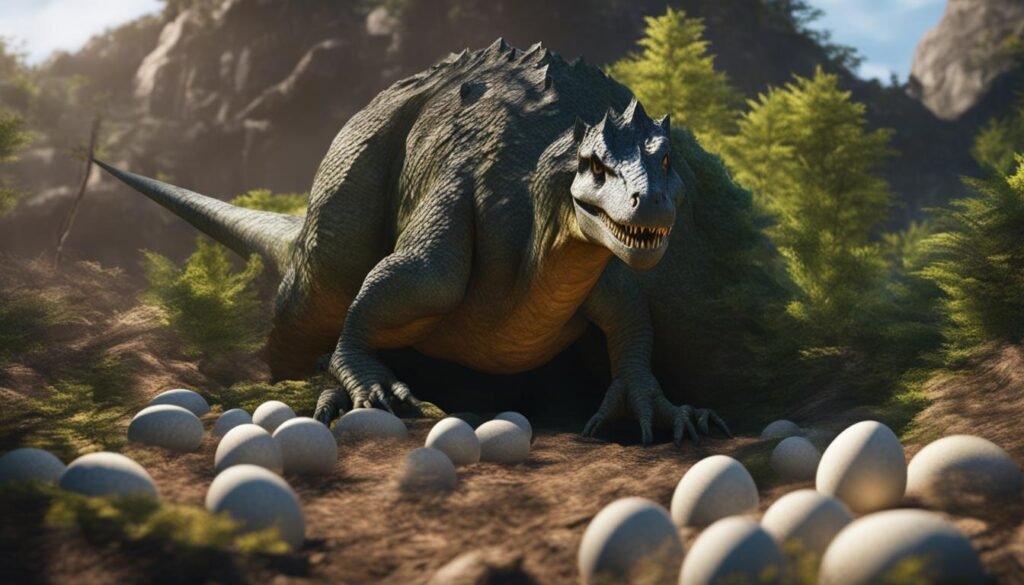
Inferences from Nesting Behavior and Maternal Care
The presence of nesting behavior and maternal care in dinosaurs suggests a level of complexity and social organization among certain species. The selection of nest sites, the arrangement of eggs, and the provision of warmth and protection demonstrate a custodial instinct among dinosaur parents. This behavior indicates that dinosaurs invested time and energy in ensuring the survival of their offspring.
The identification of nesting structures and the presence of fossilized embryos offer glimpses into the reproductive lives of dinosaurs and provide insights into their nesting adaptations and environmental influences. By examining these aspects of dinosaur behavior, scientists can further unravel the mysteries of their reproductive strategies and gain a deeper understanding of the complex social dynamics that existed among these ancient creatures.
Embryonic Development and Hatching Process
The study of fossilized embryos provides valuable insights into the developmental stages of dinosaur eggs. These well-preserved specimens offer a glimpse into the growth and changes that took place within the egg as the embryo developed. Fossilized embryos are typically found with yolk sacs, which served as a source of nutrition for the developing dinosaur. This crucial feature allowed the embryo to acquire the necessary energy for its growth and development.
The hatching process in dinosaurs involved the breaking of the eggshell and the emergence of the hatchling. The exact mechanisms by which the embryo hatched are still the subject of scientific investigation. However, evidence suggests that dinosaurs likely used specialized structures, such as an egg tooth or a pecking motion, to break the eggshell. This process may have been aided by muscular contractions or movements within the embryo to facilitate its escape from the confines of the egg.
To gain a more comprehensive understanding of dinosaur embryonic development and the hatching process, paleontologists analyze the specific features and characteristics of fossilized embryos. These investigations help shed light on the timing, sequence, and duration of developmental stages in different dinosaur species. By examining the remains of these ancient embryos, scientists can reconstruct the early life stages of dinosaurs, providing valuable insights into their growth patterns and life histories.
| Developmental Stage | Characteristics |
|---|---|
| Early Embryonic Stage | Small size, partially formed limbs, undeveloped skull |
| Mid-Embryonic Stage | Fully formed limbs, more developed skull, distinct body features |
| Late Embryonic Stage | Nearly complete skeletal structure, well-defined body features |
| Pre-Hatching Stage | Fully formed skeletal structure, ready for hatching |
These developmental stages provide a timeline of the growth and maturation of dinosaur embryos. By comparing these stages across different species, scientists can gain insights into the variations and similarities in dinosaur embryonic development. This knowledge contributes to our understanding of how dinosaurs developed from embryos to fully formed hatchlings, and how they adapted to their environment upon hatching.
Environmental Influence on Dinosaur Eggs
The survival and development of dinosaur eggs were significantly influenced by the environment in which they were laid and incubated. Temperature regulation played a crucial role in determining the success of embryo development and the overall survival rates of dinosaur eggs. The ability of the eggshell to regulate the exchange of gases between the embryo and the external environment was also impacted by environmental conditions.
Studies have shown that variations in incubation temperature can have a profound effect on the growth and development of dinosaur embryos. Higher temperatures can accelerate embryo development, resulting in shorter incubation periods, while lower temperatures can slow down development and prolong incubation. These temperature fluctuations were influenced by both external environmental factors, such as seasonal changes, and internal factors within the nest, such as the behavior of the parent dinosaurs.
The surrounding climate and nesting conditions also played a role in the preservation and fossilization of dinosaur eggs. The presence of sedimentary layers and protective nest structures could enhance the chances of egg preservation by shielding them from destructive factors such as erosion and predation. The environmental conditions during fossilization, including the composition of the sediment and the presence of minerals, further influenced the preservation of eggs and the retention of their structural features.
| Environmental Factors | Influence on Dinosaur Eggs |
|---|---|
| Temperature Fluctuations | Affects embryo development and incubation period |
| Nesting Conditions | Impacts preservation and fossilization |
| Sedimentary Layers | Protects eggs from erosion and predation |
| Fossilization Conditions | Affects the retention of structural features |
“The environment played a critical role in shaping the fate of dinosaur eggs. By studying the influence of temperature regulation and nesting conditions, paleontologists can gain valuable insights into the reproductive strategies and behavior of these ancient creatures.”
Understanding the environmental influences on dinosaur eggs not only provides insight into their past, but also sheds light on the challenges faced by modern-day organisms that rely on egg-laying as a reproductive strategy. By examining the survival rates and factors that affected dinosaur eggs, scientists can draw parallels to present-day species and better understand the delicate balance between environmental conditions and reproductive success.
Comparative Study with Avian and Crocodilian Eggs
Comparative studies between dinosaur eggs and avian and crocodilian eggs provide valuable insights into the reproductive physiology and evolutionary relationships of these ancient creatures. By examining the similarities and differences in the microstructure and structural components of the eggshells, scientists can draw conclusions about the reproductive organs and behaviors of dinosaurs, birds, and crocodiles.
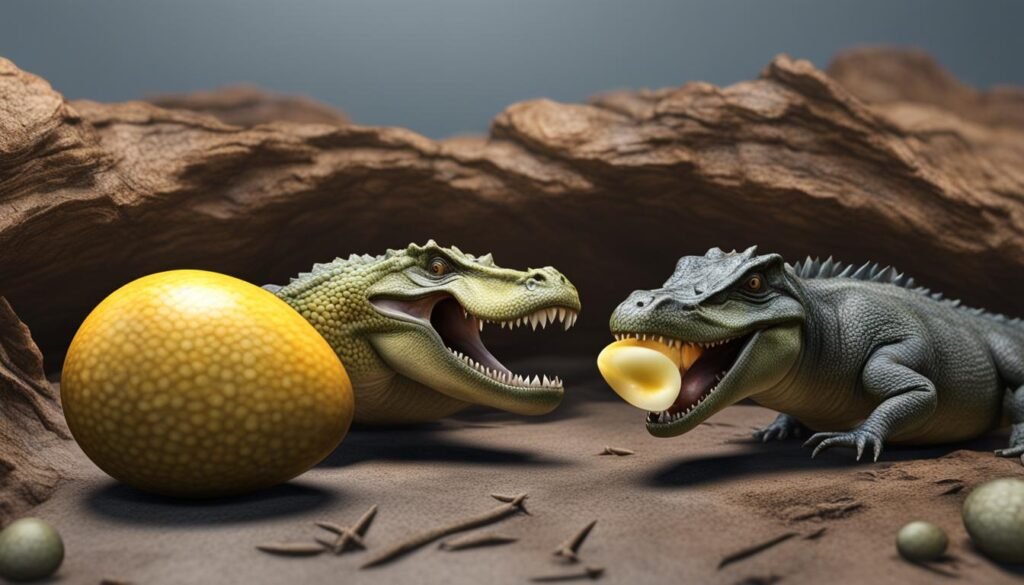
One key area of comparison is eggshell thickness. Avian eggs have a calcified shell that is usually thin and fragile, whereas crocodilian eggs have a relatively thick and leathery shell. Dinosaur eggs fall somewhere in between, with a range of shell thicknesses depending on the species. This difference in shell thickness suggests distinct reproductive strategies among these groups. Avian eggs may prioritize efficient gas exchange, while crocodilian eggs emphasize protection against predators and environmental conditions. Dinosaur eggs likely had a balance between these two factors, indicating a unique combination of reproductive traits.
The microstructure of the eggshells is another aspect that researchers compare. Both dinosaurs and birds have eggshells with pores that allow gas exchange between the embryo and the surrounding environment. Crocodilian eggs, on the other hand, have a non-porous shell. This difference suggests different incubation conditions and thermoregulatory mechanisms. Avian and dinosaur eggs may rely on environmental temperature fluctuations for incubation, while crocodilian eggs exhibit temperature-dependent sex determination.
| Dinosaur Eggs | Avian Eggs | Crocodilian Eggs | |
|---|---|---|---|
| Shell Thickness | Varies depending on species and reproductive strategy | Thin and fragile | Relatively thick and leathery |
| Shell Microstructure | Porous for gas exchange | Porous for gas exchange | Non-porous |
| Incubation Strategy | Temperature-dependent, influenced by environmental conditions | Temperature-dependent, influenced by environmental conditions | Temperature-dependent, determined by nest placement |
In summary, comparative studies between dinosaur eggs, avian eggs, and crocodilian eggs shed light on the unique reproductive strategies and behaviors of these ancient creatures. Through the examination of eggshell thickness and microstructure, as well as incubation strategies, scientists can gain valuable insights into the evolution and biology of dinosaurs. By understanding these comparative aspects, we can better appreciate and interpret the fascinating world of dinosaurs and their ancient relatives.
Conclusion
In conclusion, paleontological research on dinosaur eggs has provided valuable insights into the structure, development, and reproductive strategies of these magnificent creatures. Through the classification system of parataxonomy, scientists have been able to organize and communicate their findings on dinosaur eggs without prior knowledge of the egg-laying species. By studying the eggshell morphology, embryonic development, nesting behavior, and environmental influences, we have gained a deeper understanding of the paleobiology of dinosaurs and their evolutionary history.
Paleontological research on dinosaur eggs plays a crucial role in unraveling the mysteries of these ancient creatures. By examining the calcium carbonate deposition and porous membranes that make up the eggshell, scientists have discovered how it regulates gas exchange and temperature during incubation. Additionally, the study of fossilized embryos has provided insights into the developmental stages of dinosaur eggs and the hatching process.
By comparing dinosaur eggs with avian and crocodilian eggs, we can draw parallels between these species and gain further understanding of dinosaur reproductive physiology and evolutionary relationships. The similarities in eggshell microstructure and structural components suggest common features in the reproductive organs of dinosaurs, birds, and crocodiles, aiding in the inference of dinosaur reproductive strategies and behaviors based on their living relatives






